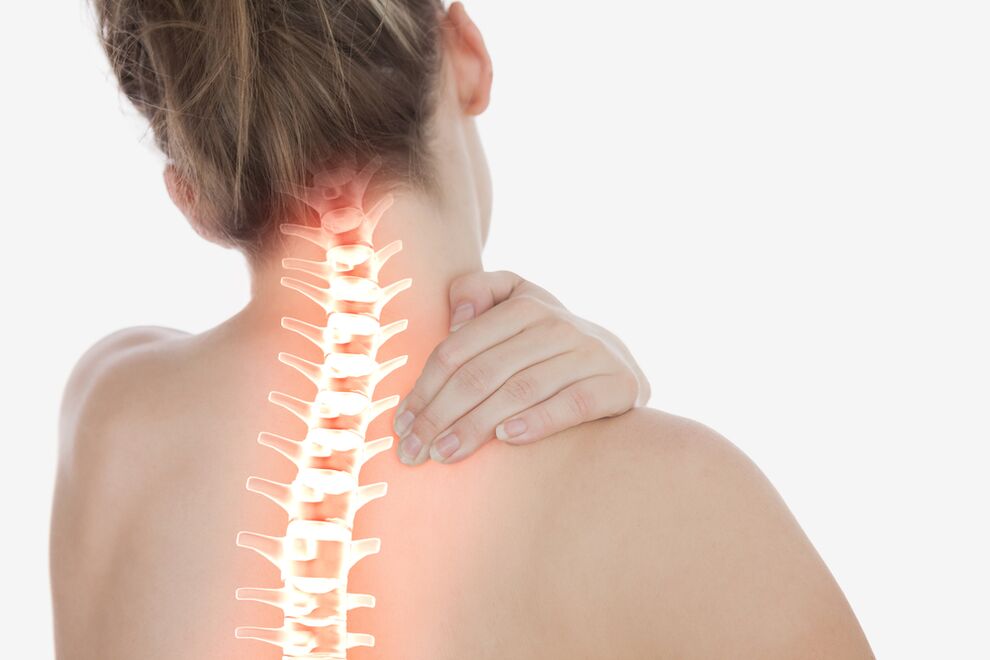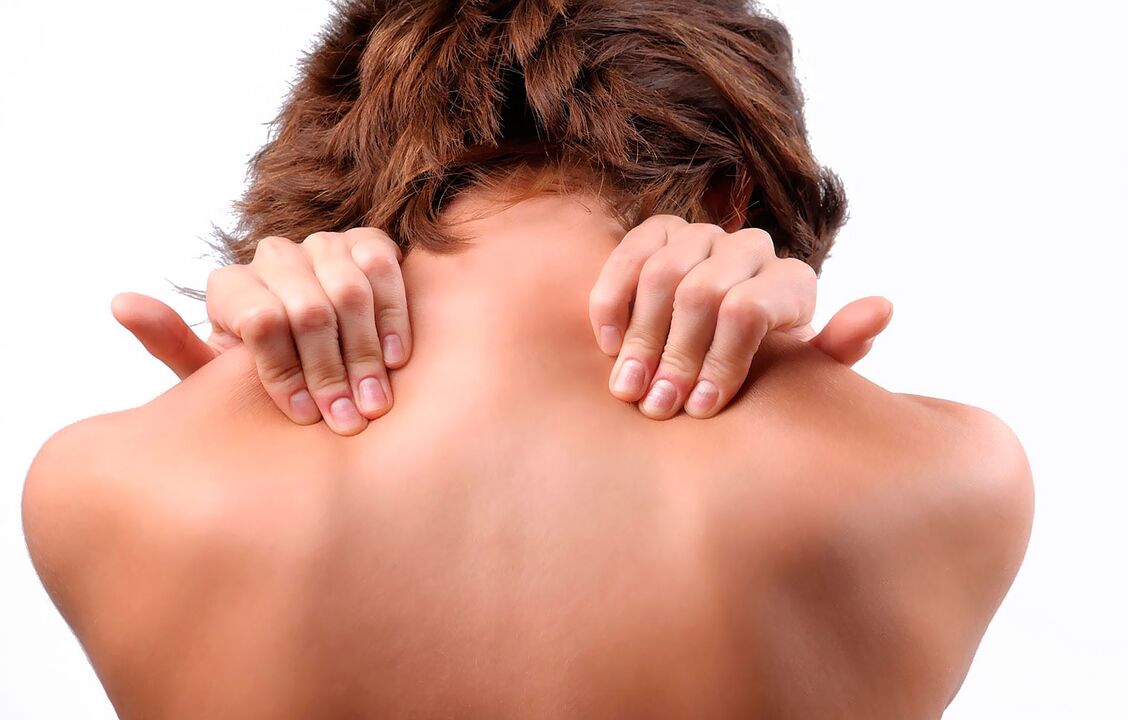Spinal osteochondrosis is a disease caused by the destruction of bone tissue and cervical, thoracic and lumbar cartilage.
First of all, with the progress of the disease, the central part of the spinal disc is modified - the nucleus of the so -called jets. Because of this, the vertebrae loses some of its properties that absorb shock, and refining and cracks form in the fibrous ring along the periphery of the disk.

Further progression of spinal osteochondrosis leads to complications of the disease - extension of discs or fractures of a fibrous ring and intervertebral hernia, consequently. Spinal cord instability in the affected area leads to pain and limited head movement in the cervical spine osteochondrosis, as well as limited body mobility with osteochondrosis of the spine and thoracic lumbar.
In 75% of cases, it is exactly the osteochondrosis of the spine that is the cause of back pain. With age, the risk of spinal tissue dystrophy increases significantly, therefore, on average, the symptoms of osteochondrosis of the spine are observed in every second inhabitants of the planet over 30 years.
Causes of osteochondrosis of the spine
Provocative factors in the development of spine osteochondrosis are considered to be returned damage or systematic load on the back with difficult physical work or professional employment in tremors. If you have to do a lot of loading and download work, buy plumbing for your car.
Early manifestation of the symptoms of osteochondrosis of the spine is caused by poor physical development, flat feet or excess weight. There is also a genetic predisposition to the loose structure of intervertebral discs and abnormalities of the spine structure. Intense fitness training contrary to the rules for distribution of load on the back, a sedentary lifestyle and improper nutrition are also unfavorable in terms of spine health.
Symptoms of osteochondrosis of the spine
The disease manifests itself as a number of typical symptoms. The osteochondrosis of the spine is characteristic: pain in the back pain, a sensation of numbness in the affected spine, a decrease in amplitude of movements, increased pain in increasing severity, sharp movement, tension during cough or sneezing.
Chronic pain, as one of the symptoms of osteochondrosis of the spine causes increased fatigue. When compressing the nerve roots of the spine, the pain can be stronger and is sharper. Its localization in this case is not limited to the back area, but is felt by a person in the limb area.
The stages of osteochondrosis of the spine
The stage of the disease depends on the severity of the symptoms of osteochondrosis of the spine. In the first phase of spinal osteochondrosis, the pain practically does not feel if only mild abuse and poor spine stability for injuries. Destruction of the fibrous ring, a decrease in the size of vertebral cracks and the pain of varying intensity is a symptom of osteochondrosis of the second phase.
The third stage of the disease is characterized by significant bone and vertebral tissue deformities until the appearance of intervertebral hernia. The symptom of osteochondrosis of the spine of the fourth most severe phase is the growth of mass bone, limited mobility, severe pain, as well as complete or partial paralysis of the limbs caused by compression of the nerve roots.
Symptoms of osteochondrosis of the cervical back
Osteochondrosis of the cervical spine often leads to circulatory disorders due to compression of the arteries. This leads to intense headaches, dizziness and pallor. With osteochondrosis of the cervical spine, vertebral artery syndrome is sometimes observed. It is characterized by a sense of noise on the head, the image of "flies" or color spots in front of the eyes. With osteochondrosis of the cervical spine, peripheral pain in the shoulders or hands are also possible.
Symptoms of osteochondrosis of the spine of the chest
The osteochondrosis of the spine of the chest can worsen the flow of various heart pathologies. The disease causes the neuralgia to progress in question (by squeezing the nerves of the relationship). With osteochondrosis of the spine of the chest, chest pain and "stock" sensation in the center of the chest are observed.
Symptoms of osteochondrosis of the spine

The lumbar spine osteochondrosis leads to the development of the following diseases: lumbago and hernia.
Ishias, as one of the complications of lumbar spine osteochondrosis, is characterized by damage to the sciatica, pain in the gluteal region, hypotension (reduced tone) of the calf and gluteal muscles.
With a lumbago symptom of lumbar spine osteochondrosis, there is a sharp pain in the lower back, caused by a shift of vertebrae or loss of the spinal cord.
Lumbar radiculitis, another complication of lumbar spine osteochondrosis, is provoked by the hernia of lower spine discs. It is associated with pain in the buttocks with radiation in the back of the thigh, a knee hole, a lower leg and foot.
Diagnosis of osteochondrosis of the spine
Preliminary diagnosis of "spinal osteochondrosis" is determined by the neurologist after initial examination regarding the patient's complaints about back pain and limited movement. The osteochondrosis phase of the spine is found depending on the degree of spinal deformity, the behavior of the patient and the number of the affected discs.
All of the above symptoms of osteochondrosis of the spine are diagnosed by feeling the patient's back. The doctor also pays attention to the condition of the muscle tone. As in most cases the disease is associated with the hypertonitis of the posterior muscles.
Using tests for bending the spine, the amplitude of the patient's movements is determined. Thanks to the use of radiography, CT and MRI, the diagnosis is specified and determined future tactics of spinal osteochondrosis treatment.
The treatment of osteochondrosis of the spine
In the treatment of spinal osteochondrosis, conservative and surgical methods are used. The purpose of both is to eliminate the pain syndrome and prevent further progression of spine deformation.
At the same time, surgical treatment of spinal osteochondrosis is used only if conservative therapy of the disease is ineffective.
The active stage of application of conservative methods lasts 2 months on average. At the beginning, a short -term increase in pain syndrome caused by the body's response to medicines, physiotherapy exercises (exercise therapy) and physiotherapy. In the conservative treatment of spinal osteochondrosis, massage, manual therapy, extract and reflexology are also used. The effectiveness of treating the spine osteochondrosis depends on the systemic nature of the procedures and the patient's own perseverance in executing the complexes of exercise therapy.
Surgical treatment of spinal osteochondrosis is performed with an intervertebral disc herniation, long ago that exceeds 6 months. The story of the operation is also a decrease in the gap between the vertebrae to 1/3 of the initial size and compression of the spinal cord roots.
The main method in the surgical treatment of osteochondrosis of the spine is discoctomy, d. m. th removing a deformed disk. The surgery can be minimally invasive using endoscopic tools using the microdishtomy method, B-twinning system, and laser evaporation of a deformed disk.
After surgical treatment of osteochondrosis of the spine, a rehabilitation period for 6 months is expected. During it, the patient is directed in the treatment of the sanatorium resort to undergo a course of physiotherapy, manual therapy, acupuncture, etc.



















